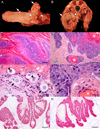Pathology in Practice
- PMID: 35905169
- PMCID: PMC11472644
- DOI: 10.2460/javma.20.12.0688
Pathology in Practice
Abstract
In collaboration with the American College of Veterinary Pathologists.
Figures


Similar articles
-
Pathology in Practice.J Am Vet Med Assoc. 2022 May 20;259(S2):1-4. doi: 10.2460/javma.21.04.0201. J Am Vet Med Assoc. 2022. PMID: 35587911
-
Pathology in Practice.J Am Vet Med Assoc. 2022 May 20;259(S2):1-4. doi: 10.2460/javma.21.04.0191. J Am Vet Med Assoc. 2022. PMID: 35587910
-
Pathology in Practice.J Am Vet Med Assoc. 2022 May 20;259(S2):1-5. doi: 10.2460/javma.21.05.0253. J Am Vet Med Assoc. 2022. PMID: 35587909
-
Pathology in Practice.J Am Vet Med Assoc. 2022 May 20;259(S2):1-4. doi: 10.2460/javma.21.04.0209. J Am Vet Med Assoc. 2022. PMID: 35587908
-
Forensic pathology of companion animal abuse and neglect.Vet Pathol. 2013 Nov;50(6):994-1006. doi: 10.1177/0300985813488895. Epub 2013 May 17. Vet Pathol. 2013. PMID: 23686766 Review.
References
-
- Gil da Costa RM, Peleteiro MC, Pires MA, et al. An Update on Canine, Feline and Bovine Papillomaviruses. Transbound Emerg Dis 2017;64:1371–1379. - PubMed
-
- Delius H, Van Ranst MA, Jenson AB, et al. Canine oral papillomavirus genomic sequence: a unique 1.5-kb intervening sequence between the E2 and L2 open reading frames. Virology. 1994;204:447–452. - PubMed
-
- Lange CE, Tobler K, Brandes K, et al. Canine inverted papillomas associated with DNA of four different papillomaviruses. Vet Dermatol 2010;21:287–291. - PubMed
-
- Falk E, Lange CE, Jennings S, et al. Two cutaneous horns associated with canine papillomavirus type 1 infection in a pit bull dog. Vet Dermatol 2017;28:420–421. - PubMed
-
- Nicholls PK, Klaunberg BA, Moore RA, et al. Naturally occurring, nonregressing canine oral papillomavirus infection: Host immunity, virus characterization, and experimental infection. Virology 1999;265:365–374. - PubMed
MeSH terms
Grants and funding
LinkOut - more resources
Full Text Sources

